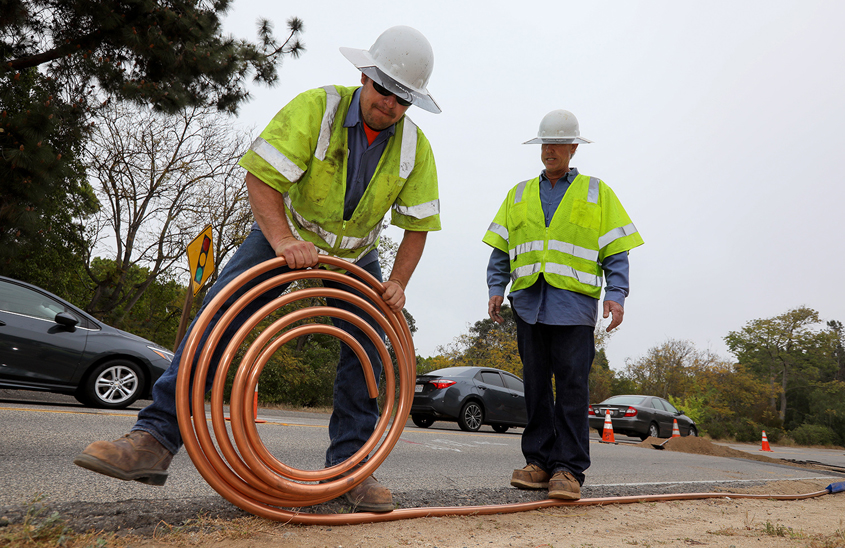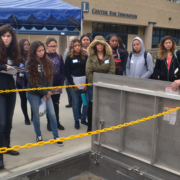You are now in Media Coverage San Diego County category.
California’s Infrastructure Gets C- in New Report Card
A new report gave California’s infrastructure a grade of C-, which means it requires attention despite being better than the country’s average. The report by the American Society of Civil Engineers (ASCE) said California’s infrastructure is average when graded in 17 categories, including aviation, roads, transit, drinking water, and more. The annual infrastructure report card talked about the progress San Diego has made and where the city needs to improve.
How LADWP Uses Two Lakes To Store Energy Like A Giant Battery
If L.A. is going to stop burning fossil fuels by 2045 a key goal of Mayor Eric Garcetti’s proposed Green New Deal it must store a lot more of the excess solar and wind energy it produces during the day so it doesn’t have to rely on gas and coal energy to power the city when the sun sets and the wind dies. There’s a growing focus on building big batteries — for example, the kind that use lithium ions. But L.A. needs energy storage that is far bigger than any traditional battery.
San Diego Climate Change Group Advocates For Local Green New Deal Support
A San Diego-based group of environmental activists launched a 100-day campaign Monday calling on the region’s congressional representatives to support the Green New Deal to mitigate the effects and exacerbation of climate change. San Diego 350 hopes to convince Reps. Susan Davis and Scott Peters, D- San Diego, and Duncan Hunter, R-Alpine, to support the resolution by inundating their offices with calls and postcards from constituents between now and the August congressional recess.
Snow In May? Sierra Could Get Up To A Foot As Rare Cold Storm Sweeps Over California
In addition to wet weather and possible record-setting cold in the Sacramento Valley and foothills later this week, the Sierra will see snow showers Thursday and into the weekend. With temperatures dipping as low as 25, a rare mid-May snowstorm could affect the northern and central Sierra. In a special weather statement early Monday, National Weather Service’s Reno office warns that snow levels could fall to 6,000 feet by the end of the week. Forecasts for the mountains and foothills also show wind gusts up to 40 mph are possible by midweek, with even stronger winds expected.
Aging Water Workforce Spurs Industry Recruiting Efforts
A flood of water industry professionals nearing retirement has prompted local agencies to form a task force charged with assessing ways to develop the water workforce of the future. Education leaders are stepping up outreach to fill their career training programs, and water agencies are looking for new ways to attract employees.
“For many years now, we’ve been talking about the ‘Silver Tsunami’ of aging baby boomers who are going to be leaving the workforce, but it really is coming to fruition now,” said Don Jones, who helped spearhead Cuyamaca College’s new Center for Water Studies housing the college’s Water & Wastewater Technology program. “Almost one-third of water industry professionals will be at or nearing retirement age in the next few years. When you combine that with the fact that the unemployment rate is already at record or near-record lows and other industries are facing the same challenges and going after the same people we are, we have some serious work to do.”
Those concerns have spurred the San Diego County Water Authority and other agencies to convene a regional task force comprising utility directors and general managers, which has been meeting for months to assess workforce-related challenges, collect and analyze employment data, and craft a plan for moving forward.
Water industry offers competitive salaries

Approximately 40 percent of the Fallbrook Public Utility District ‘s 68 employees will be eligible to retire within five years. Seventeen percent are currently eligible for retirement. Photo: Fallbrook PUD
The regional water and wastewater industry expects to need to fill approximately 400 positions annually to keep pace with retirements and vacancies caused by employees leaving the area.
The challenges face both large and small agencies. In the City of San Diego, 640 of approximately 1,600 water industry professionals will be eligible to retire within the next three to four years. At the Fallbrook Public Utility District approximately 40 percent of the agency’s 68 employees will be eligible to retire within five years. Seventeen percent are currently eligible for retirement.
“These are good-paying jobs with good benefits, but you just don’t find a lot of people coming out of school who are interested, and we are struggling to attract skilled employees from the private sector,” said Jack Bebee, Fallbrook general manager.
Bebee pointed to the recent posting of a senior engineering position at the utility that pays an annual salary of close to $150,000. The district thought the salary would be competitive enough to draw people from the private sector, but only one of four applicants was from the private sector. When Bebee was hired for a similar position nine years ago, he competed against 40 other applicants.
A 2018 Brookings Institution report notes the employment void exists even though water workforce occupations not only pay more on average compared to all occupations nationally, but also pay up to 50 percent more to workers at the lower ends of the income scale. In San Diego County, water and wastewater plant and systems operators are earning an average salary of $70,000 annually, according to the U.S. Bureau of Labor Statistics.
Skilled workers needed to operate increasingly complex systems
While the Bureau of Labor Statistics notes that fewer people may be needed in coming years as water and wastewater plants become more automated, a skilled workforce is required to operate increasingly complex controls and systems. Some of the most advanced facilities in the world are in Southern California, including the Claude “Bud” Lewis Carlsbad Desalination Plant, the naton’s largest desalination plant.
Local educational efforts in the industry are addressing the potential worker shortage:
- Palomar College’s Water and Wastewater Technology programs, provides pre-employment training and advanced courses for people who want to become certified as a water or wastewater operator.
- The Water Authority’s student internship program pays $12 an hour and has interns working at four different water agencies throughout the year.
- California State University, San Marcos Certificate in Water Management & Leadership program is geared toward workers already employed as intermediate-level supervisors in the water industry and offers training and skills needed for higher management positions.
- The Center for Water Studies at Cuyamaca College.
The Brookings report noted the glut of retirements offers an opportunity to diversify the industry. In January, the Center for Water Studies held the first in an annual series of Women in Water symposiums, attracting several hundred women and high school girls from throughout Southern California interested in a new career.
“Challenges can prompt people to get together and look at new ways of doing things,” said Greg Thomas, general manager at the Rincon del Diablo Municipal Water District in Escondido. “This is a great industry, it pays well, and you’re doing something good for people and society.”
A New Water Tax Might Be California’s Best Chance At Clean Water For All
At least 1 million Californians don’t have stable access to clean drinking water. That’s a shameful and unacceptable fact in this wealthy state. In his February State of the State address, Gov. Gavin Newsom called the safe drinking water crisis which is centered in lower-income communities ranging from the coasts to the Central Valley “a moral disgrace and a medical emergency.”
March-Like Storm To Blast California With Drenching Rain, Mountain Snow and Severe Weather
After sunshine and pleasant weather grace California early this week, a powerful storm system will barrel into the state during the middle to latter part of the week. The return of a March-like weather pattern, driven by a large dip in the jet stream, will be the culprit for driving this rare storm into the West Coast. Rain will first move into Northern California on Wednesday before overspreading the rest of the state by Wednesday night and Thursday. By the time the storm moves into the Four Corners region later on Friday, the foothills of the Sierra Nevada and parts of Northern and coastal California will receive between 1 to 3 inches of rain.
New Dam Proposal In Sierra Nevada Stirs Debate Over California Energy Policy
Up a remote canyon in the towering eastern Sierra, a Southern California company has an ambitious plan to dam the area’s cold, rushing waters and build one of the state’s first big hydroelectric facilities in decades. The project, southeast of Yosemite near the town of Bishop (Inyo County), faces long regulatory odds as well as daunting costs. But residents of the Owens Valley downstream and state environmentalists are not taking it lightly. The complex, as proposed in an application to the Federal Energy Regulatory Commission last month, is scheduled for mostly federal land at the edge of the Inyo National Forest, partly in the popular John Muir Wilderness.
Aging Water Workforce Spurs Industry Recruiting Efforts
A flood of water industry professionals nearing retirement has prompted local agencies to form a task force charged with assessing ways to develop the water workforce of the future. Education leaders are stepping up outreach to fill their career training programs, and water agencies are looking for new ways to attract employees. “For many years now, we’ve been talking about the ‘Silver Tsunami’ of aging baby boomers who are going to be leaving the workforce, but it really is coming to fruition now,” said Don Jones, who helped spearhead Cuyamaca College’s new Center for Water Studies housing the college’s Water & Wastewater Technology program.



